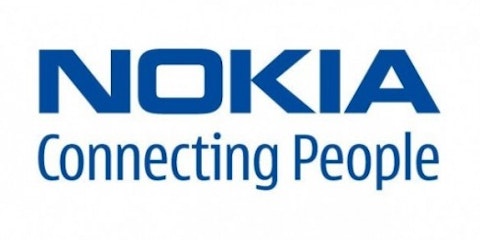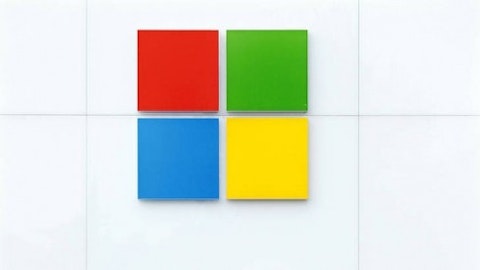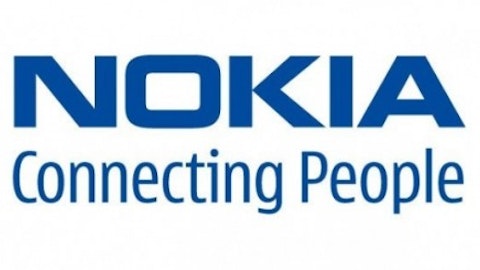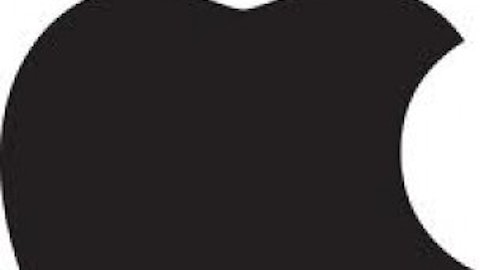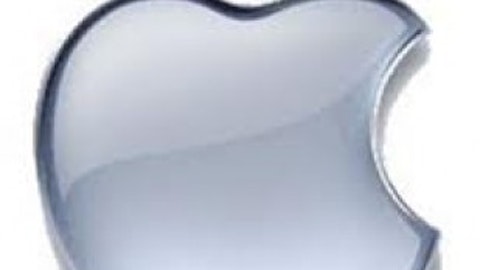Cellular phones are capable of performing a variety of tasks. I remember when they were similar in shape to bricks, ultra-heavy, and with huge antennas, dangerous indeed.
In the late 90s, novel technologies, mainly from Nokia Corporation (ADR) (NYSE:NOK), allowed for the creation of smaller cellphones. This technology was incredible, and the phones’ portability improved dramatically. A bright green screen that measured about one inch allowed for users to send and receive text messages. In June 2000, Nokia peaked at $60 per share.
Currently, Nokia Corporation (ADR) (NYSE:NOK) trades at $3.50 per share. Its negative P/E does not sit well with the value-oriented investor. According to its most recent earnings report, revenue declined 21% to $5.8 billion. The volume of smart devices declined 49% to 6.1 million units. The number of mobile phones sold declined 21% to 55.8 million. According to the company, five million Nokia Asha smartphones were sold. However, I think the demand for Ashas should decrease since they operate with 2G internet band technology, while the standard is 4G. The number of devices shipped to China declined by 63%. I believe this is a key aspect, and it will be discussed in brief. Lastly, it should be noted that Nokia received $250 million from Microsoft Corporation (NASDAQ:MSFT) for the “platform support payment” concept. Although it may be argued that this is a stable income source for Nokia, if Microsoft decides to stop using this system due to profitability issues, the payment will stop. What troubles me is that this is a real possibility, since the Windows Phones have not been as successful as expected.
Going back to our little story, Nokia Corporation (ADR) (NYSE:NOK) stopped the innovations in the cellular phone industry. Other companies like Research In Motion Ltd (NASDAQ:BBRY) rose by developing new technologies. Research in Motion unveiled the BlackBerry phone, which integrated a “qwerty” keyboard. The time required to type a text message was reduced considerably, and the device was a total success. In 2007, Research in Motion peaked at $230 per share. Its current price per share is $14.
If you are searching for the reason of the decline in price, the answer is simple: there were no innovations in the company’s R&D pipeline. Although the number of BlackBerries sold reached the 200 million units mark, sales have decelerated at an alarming pace. BlackBerry 10 was the latest product from the company, but it was a complete disaster. The company spent huge piles of cash developing its new operating system and new devices. However, the reception of the BB10 was poor, and only one million units were sold in two months.
According to the company’s most recent quarterly earnings report, revenue fell 36% to $2.7 billion on a year-over-year basis. The company shipped approximately six million BlackBerry smartphones, including one million BlackBerry 10s. The company is trading with a negative P/E and a negative forward P/E. Although its net income was $98 million, or $0.19 per share, its cash from operating activities fell by $600 million. I believe the company’s fundamentals are not solid at the moment.
The real cellphone revolution
Apple Inc. (NASDAQ:AAPL) was the cause of death for Nokia Corporation (ADR) (NYSE:NOK) and Research in Motion after the iPhone was released in 2007. The cellular phone design changed forever. The price of the phone was relatively expensive, yet thousands of devices were sold almost instantly. The decline of Nokia, Motorola, and Research in Motion started at that point.
A key feature of the iPhone was its versatility. The iPhone was designed for multitask purposes, while competitors BlackBerry OS, Symbian, and Windows Mobile were not designed to handle tasks beyond communication. The newer iPhone 4 and 4S were also blockbusters. While one million BlackBerry 10 units were sold in two months, the iPhones sold one million units the day they were released.
Apple Inc. (NASDAQ:AAPL) shares jumped from $120 in June 2007 to $700 in September 2012, one day after the release of the iPhone 5. Since then, the stock has been on a major decline, trading as low as $400 in April 2013. The main reason is the same as for Research in Motion and Nokia Corporation (ADR) (NYSE:NOK). Investors did not see a significant improvement in the iPhone 5, and more importantly, the company did not provide hints regarding fundamental innovations in its R&D pipeline.
According to Apple Inc. (NASDAQ:AAPL)’s most recent earnings report, its phone sales rose to 37.1 million units, compared to 35.1 million units in the same quarter last year. Revenue increased 10% to $43 billion, or $10.09 per diluted share. Its net cash and cash equivalents rose by $1.3 billion, compared to a rise of $300 million last year. It is worth mentioning that Apple trades with a P/E of 10.76 and a forward P/E of 10.31. It may look like a good investment opportunity to the traditional value-oriented investor. However, since investors always delve into the future, the company does not seem to offer new technologies. Hence, its price per share may not rise in the interim. Apple will not trade at $700 again until a novel blockbuster is unveiled.
So far, Nokia Corporation (ADR) (NYSE:NOK), Research in Motion, and Apple Inc. (NASDAQ:AAPL) are not showing signs of groundbreaking products. They provide more of the same to the customers, and we are somewhat tired of it.
The future of these companies
Nokia and Research in Motion are struggling to come up with products that can compete with the iPhone and Android-based cellphones. However, none of their products have performed as expected, and the companies are spending many resources on projects that result in failures.
Going back to Nokia Corporation (ADR) (NYSE:NOK)’s earnings report, the company’s market share in China declined significantly. In order for us to appreciate the real impact, we have to take into account that Apple Inc. (NASDAQ:AAPL) did not reach an agreement with China’s largest cellphone carrier. In other words, Nokia does not have to compete against Apple in China, and yet, its presence is dimming. In developed countries, its presence is virtually non-existent. Its revenue will continue to decrease, and I believe Nokia is done for these reasons.
The BlackBerry 10 was an utter disaster. Its sales were minimal in comparison with what the iPhone achieved on its first weekend. What’s more is that, according to its latest earnings report, Research in Motion is losing market share in emerging markets. This is significant because the company’s presence in emerging markets was huge, and a substantial percentage of the revenue came from them. Currently, there is no innovation that will come in the near future for Research in Motion, and I fear the company will go the way of the dodo bird.
Apple Inc. (NASDAQ:AAPL) is in a better position than Nokia Corporation (ADR) (NYSE:NOK) and Research in Motion. The company enjoys a significant market share because the iPhone is appealing, fast, able to multi-task, and you can get it for free from Verizon Wireless with a 2-year contract. However, the iPhone 5 did not offer the essence that makes customers want to buy the product. It is more of the same iPhone 4/4S. If Apple is not able to come up with a novel product, its price per share will decline more. The competition is getting tougher by the day, and investors should look for signs regarding customer reception of the new iPhone before committing in a long position.
Is the cellphone industry dead?
On the contrary, I believe it is barely starting. However, Google Inc (NASDAQ:GOOG) and Samsung will be the main players going forward.
Google has been working on a new device called Google Glass. The device is a wearable computer with a head-mounted display (HMD) that resembles a pair of glasses. The internet will be accessed through voice commands. The company is trying to partner with sunglass manufacturers such as Ray-Ban to develop these glasses. Eventually, the frame will be able to incorporate prescription-lenses to expand its customer base.
A test edition, called “explorer edition,” runs for $1,500, but the price is expected to drop to around $600 once production begins. I believe that this will be a major blockbuster, and it may be the catalyst that Google Inc (NASDAQ:GOOG) needs to break the $1,000-per-share level. Further, the release of Google Glass will send Nokia and Research in Motion stocks to penny land, and they will be forever gone.
From the fundamental analysis point of view, the company trades with a P/E of 25.83 and a forward P/E of 16.32. Its P/E is below the industry average of 50.8. Its balance sheet carries no significant debt. Taking into account the company’s size, its sales increased 30% to $13.9 billion, and its net income increased 15% to $3.4 billion. In brief, I believe Google Inc (NASDAQ:GOOG) should be in every growth portfolio.
